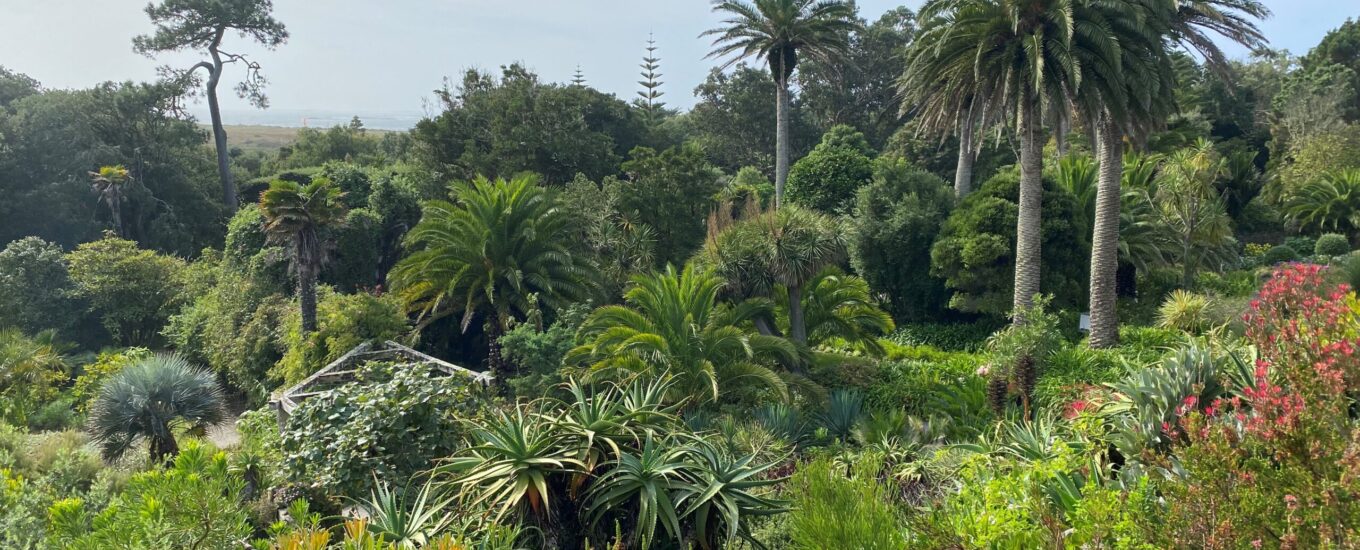A postcard from Tresco Abbey Gardens
STORIES

Ollie Whitehead, Curator of Public Programmes
The endorsement of ‘warmest place in the UK’ may sound like a dubious consolation prize, but the Isles of Scilly, an archipelago made up of around 200 islands and rocks roughly 40km southwest of Land’s End in Cornwall, are just that. 

 The garden is cool, damp, and shady at the lower levels, and makes way for much warmer and brighter conditions the higher up the hillside one travels. The species growing here originate from across the globe, but particular collecting focus is given to the southern hemisphere; from Australia and New Zealand, to South Africa and Brazil. Walking around with Head Gardener Andy Lawson, he uses Chile as the simplest way to describe the breadth and depth of the collection; despite being only 445km at the widest point, the country’s 4270km length has at least seven climatic sub-zones; from arid, desert, subtropical, Mediterranean, to temperate and alpine, and most of these are replicated on this 17 acre site. As we wander, it strikes me: I haven’t seen quite so many healthy aeoniums and pine trees together since Sarah Price’s Benton End-inspired designs from Chelsea Flower Show earlier this year. Aeonium cunatum and Crassula multiclava have successfully colonised stonework, and the former are in fact so happy that it’s not uncommon for the garden to see their own cross-bred hybrids. Making my way through, I was heartened to recognise two species that we host at the Garden Museum; the soon-to-flower Mexican tree dahlia and the unmistakable wavey shapes of the Agave americana. Our gardens team have just moved the latter to one of our glasshouses in the front garden for its participation in a display relating to our upcoming exhibition; a show exploring the work of the Antiguan artist, gardener, and radical, Frank Walter.
The garden is cool, damp, and shady at the lower levels, and makes way for much warmer and brighter conditions the higher up the hillside one travels. The species growing here originate from across the globe, but particular collecting focus is given to the southern hemisphere; from Australia and New Zealand, to South Africa and Brazil. Walking around with Head Gardener Andy Lawson, he uses Chile as the simplest way to describe the breadth and depth of the collection; despite being only 445km at the widest point, the country’s 4270km length has at least seven climatic sub-zones; from arid, desert, subtropical, Mediterranean, to temperate and alpine, and most of these are replicated on this 17 acre site. As we wander, it strikes me: I haven’t seen quite so many healthy aeoniums and pine trees together since Sarah Price’s Benton End-inspired designs from Chelsea Flower Show earlier this year. Aeonium cunatum and Crassula multiclava have successfully colonised stonework, and the former are in fact so happy that it’s not uncommon for the garden to see their own cross-bred hybrids. Making my way through, I was heartened to recognise two species that we host at the Garden Museum; the soon-to-flower Mexican tree dahlia and the unmistakable wavey shapes of the Agave americana. Our gardens team have just moved the latter to one of our glasshouses in the front garden for its participation in a display relating to our upcoming exhibition; a show exploring the work of the Antiguan artist, gardener, and radical, Frank Walter. 

 Dotting the hillside, perhaps nothing is more magnificent than the Norfolk Island pine, a native of the South Pacific, which even as a healthy mature tree will die at the first sign of frost. There has been more than one occasion where an unexpected cold snap and a deviation from the virtual lack of frost on the island has had disastrous consequences; in 1987 five days of snow wiped out around 75% of the garden’s collection, forcing the team to plant and rebuild. Fundamentally, this is what can be considered as the intrinsic beauty of Tresco Abbey Garden; the very fact it exists in the first place is remarkable, but the precarious existence is the thing that significantly heightens the experience and appreciation. Here isn’t a particularly easy place to get to, but then perhaps that’s another part of its great appeal. The time travelled is well rewarded with the experience of unique conditions and specimens, and vistas unseen elsewhere in the UK. Like a double take, this is the kind of garden that has to be visited twice to be believed. Or at least, that’s what I did, and I feel much richer for it.
Dotting the hillside, perhaps nothing is more magnificent than the Norfolk Island pine, a native of the South Pacific, which even as a healthy mature tree will die at the first sign of frost. There has been more than one occasion where an unexpected cold snap and a deviation from the virtual lack of frost on the island has had disastrous consequences; in 1987 five days of snow wiped out around 75% of the garden’s collection, forcing the team to plant and rebuild. Fundamentally, this is what can be considered as the intrinsic beauty of Tresco Abbey Garden; the very fact it exists in the first place is remarkable, but the precarious existence is the thing that significantly heightens the experience and appreciation. Here isn’t a particularly easy place to get to, but then perhaps that’s another part of its great appeal. The time travelled is well rewarded with the experience of unique conditions and specimens, and vistas unseen elsewhere in the UK. Like a double take, this is the kind of garden that has to be visited twice to be believed. Or at least, that’s what I did, and I feel much richer for it.